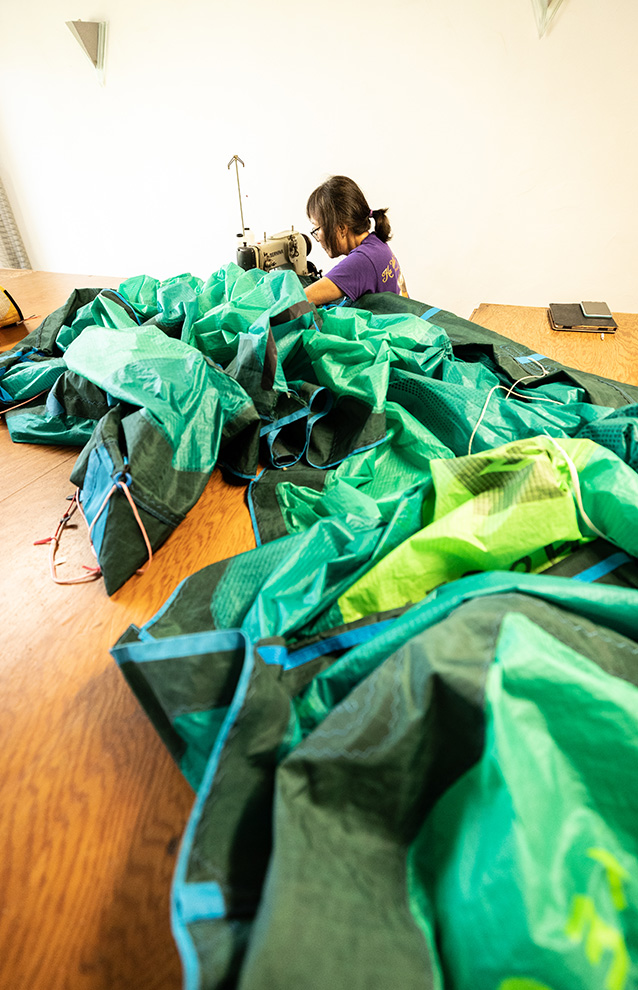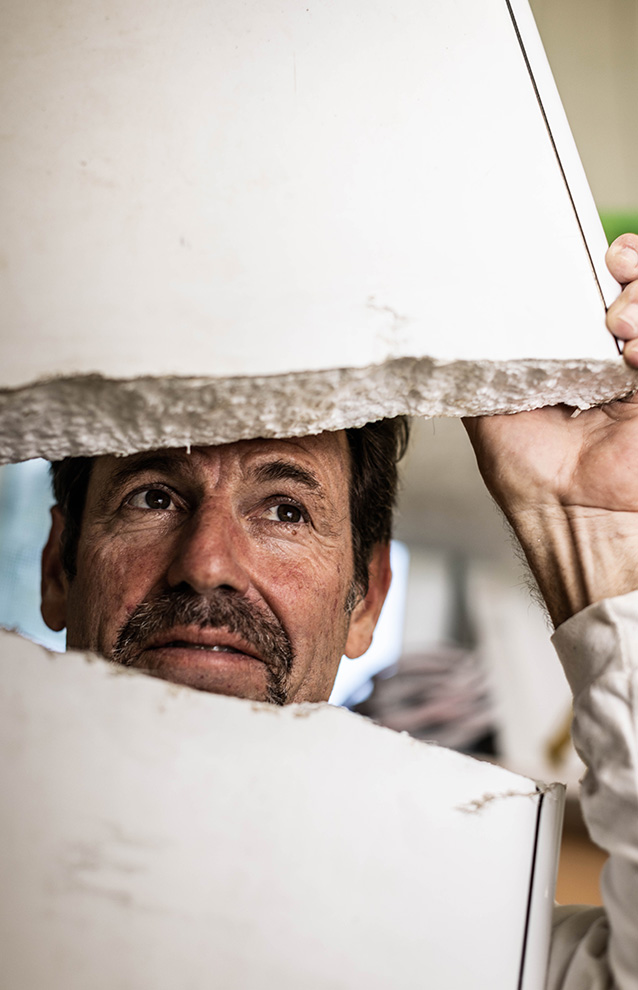One windy day on the North Shore of Oahu, Derek Hamasaki misjudged his approach to an overhead wave. The foil surfer tried to correct, but too late: The wave crashed on him, twisted his foil and sent him flying over his wing-a wide, bat-shaped kite with handles and an inflatable edge, the surfing world's latest fancy of flight. Before he could escape the whitewater, the next wave caught him. As Hamasaki and his gear tumbled, the foil sliced through almost the entire length of the $1,000 wing. "Small mistakes can cause catastrophe," he says, acknowledging the struggle-and danger-of paddling broken equipment to shore in heavy conditions. Later he recounted the ordeal to fellow wingers in a group text: "Guess what?" he wrote, "Gotta go visit Auntie Brenda again!"
Accidents happen. Sometimes it's user error—ram into another board, whack a wall rounding a corner, forget to strap your vessel to your roof racks. Other times, it's misfortune: Wildlife collides, waves pummel, reefs slash. The lightweight materials in modern watercraft are relatively fragile, and well-used equipment inevitably takes a beating.
Brenda Ching is the one woman whom every wind, wing and kite surfer has in their contacts. Typically she's listed as "Brenda, kite fixer" or "Brenda, wing repair." She might as well be "Brenda, fairy godmother," because with a wave of her arms (and two industrial sewing machines), she turns tattered pieces of fabric back into high-performance kites. The small-framed, soft-spoken Nuuanu seamstress belongs to an unsung club of behind-the-scenes fixers who undo the damage done to Hawaii's favorite water toys: boards, wings, kites, sails and canoes.
 |
 |
Seamstress Brenda Ching repairs a torn kite in her Nuuanu workshop. “Auntie Brenda” is one of a cadre of in-demand repairers with the expertise to keep Hawaii’s watermen and women doing what they love.
"A lot of people will text me pictures and ask, 'Can you fix this?'" Ching says. Unless the sail or wing or kite is too old to be worth mending, her answer is usually, "Yes, yes. I can fix that." She spreads the casualties out on an eight-by-fifteen-foot table in what used to be her living room, measuring and marking giant folds of fabric. Years of wrangling heavy canvases through the sewing machines have taken a toll on her shoulder, so she avoids working on large sails. Her garage is strewn with rolls of polyester, nylon, Dacron and other materials to keep up with the rapidly evolving industry.
Ching learned to make and repair sails in the '80s under the tutelage of Tom Nishimura, creator of Vortec Sails. After he died, she continued. With the advent of kite surfing in the '90s and wing foiling over the past few years, a new generation of dispirited watermen and women has sought her out. Drawing on her own experience as a windsurfer, Ching fixes the most stubborn tears in the trickiest of places, often applying solutions that come to her in her sleep. She has also adopted Nishimura's meticulousness: "He would change things like, a tenth of an inch," she says.
Those new to wind sports are Ching's most frequent customers. "Some guys haven't even gotten in the water yet-they launched from the beach and the kite went boom! Straight into a tree," Ching says. "That's really heartbreaking for everybody, especially if it's a new kite." After their first accident, Hamasaki says, some guys will try to duct tape or hand-sew a kite. "Your Mickey Mouse repair might fly for a little while, but then you realize no, this is not working. When you take it to Brenda and see the way she does it and how fast she turns it around, you go, 'I'm coming here every time.'"
Despite the relentlessness of the work, Ching says she has no plans to retire. "The fun part is handing it back and seeing the smile on their faces when they say, 'Wow, now I can go back out again!'"
 |
 |
"In this life your ding repair guy is just as important as your plumber, your electrician or your handyman," says North Shore surfboard surgeon Dan "Dano" Franzmann, who fixes many of the dinged, buckled and broken boards claimed by Hawaii's ferocious surf.
Two days before the National Scholastic Surfing Association's regional championships last May, rising star Nalu Deodato was practicing at Kewalos, the contest site and surf break on Oahu's south shore. He launched an aerial off the lip and landed hard, buckling the 5'8" Tokoro he was planning to use. Next morning, he rushed it over to Dan Franzmann—a.k.a. "Dano"—who fixed it and had it back to him that night. Deodato paddled it out and won the Open Juniors division.
Nalu's predicament isn't unusual, says Dano, who's earned a reputation for fixing boards fast and well. Though surfboards are shaped from a standard blank, pros are sensitive to the tiniest differences, even the density of the foam in specific parts of the board. "If the board feels magical, they'll ice it. They'll hold that board, and the day before the contest they'll break it out. They just want to get a wave or two, feel it out. Then, doh! They buckle the board."
In between surfing and studying English at Brigham Young University in Laie, Dano would hang out at Race Hawaii Surfboards in Haleiwa. Owner Scott Bucknell taught him how to work with fiberglass and resin, and he helped repair boards for the shop. The charismatic, self-described hustler soon generated his own business, fixing boards for renowned surfers like Jock Sutherland and Mark Foo, for customers of Hawaii Surf & Sail and for backpackers at Foo's hostel. That was back when a gallon of resin was $10 (today it's $50), he recalls. When Dano's parents cut him off because he took too long to finish college, ding repair paid the last year and a half of his tuition.

Canoe repairman Mike Soule examines an ama, the float of an outrigger canoe.
At 33, Dano decided he needed to make something happen. He and his wife took out a loan, moved to Vegas and opened a Wyland art gallery. "All of a sudden I had the weight of the world on my shoulders, whereas before it was just, 'Am I gonna surf in the morning, or should I wait till after lunch?'" he says. "It was super stressful but things turned out pretty well."
In 2003, the couple moved back to the North Shore and had two sons, Dylan and Makana. By the mid-2000s they were operating ten galleries in Vegas, Lake Tahoe and Hawaii. When their marriage ended, Dano traded his opulent lifestyle for a simpler one. He surfed with his boys, who became competitive. When they dinged their boards, naturally, he fixed them-and before long he was fixing others' boards as well. "In this life your ding repair guy is just as important as your plumber, your electrician or your handyman. I try to make the money those guys make, but I don't do it by gouging people," says Dano. "I do it by lining everything up and being super productive."
A true North Shore original, Dano doesn't advertise and he's not on social media, though you can usually find him on Fridays and Mondays in Honolulu at Moku Hawaii surf shop. "I don't Venmo. I don't PayPal. It's all cash and carry," he says. "I don't have one dollar of debt in my company. I don't have anyone owing me money. I'm not in the bill collector business. I'm not in the board storage business-if I text someone that their board's done and days go by, I sometimes threaten $10 a day storage. They come running." The tactic works: So far Dano hasn't actually had to charge a storage fee.
The no-nonsense entrepreneur also won't brook entitlement. "I will fire people who act like they're my only customer after I've just told them, 'Hey man, I got fifty boards here and I'm three weeks back.' If they act selfish, I'll tell them, 'Hey, take your board. Beat it.' I'm like the soup guy on Seinfeld. 'You complain? No repair for you!'"
"Dano is the rare combination of good businessman and good ding repair guy," says surfboard shaper Jon Pyzel, explaining why he entrusts Dano with the quivers of his team riders (including that of two-time world champion John John Florence). "Your boards end up in good condition, and they are finished when he says they'll be, making the few extra dollars spent well worth it."
Now 58, Dano's teaching his son Dylan how to fix boards—a dying art, he says, thanks to YouTube's many subpar instructional videos. It's not always a glamorous job—"It stinks. The dust makes you itch. There's a reason no kids are pulling on your shirttail to get into it," he says—but the appreciation is his reward. "I have the world's best customers, who hug me because I fix their toys. They bring me beer, food, pies, tips. When I'm riding down the bike path, people will yell, 'Dano! Thanks for fixing my board!' There's a saying: 'You have the power to be happy by making other people happy.' I didn't know that as directly as I do now," he grins. "I groove on it every day."

Good as new: Foiler Derek Hamasaki catches air on the North Shore of Oahu after Brenda Ching repaired a three-foot-long gash in his $1,000 wing. |
 Ching rolling up a windsurfing sail. |

PHOTO COURTESY DEREK HAMASAKI
"It was that 'one day' everyone worries about," recalls Lili Taliulu. "I got caught by a wave at Papailoa and lost my paddle. Then I smashed the nose of my canoe in the shorebreak swimming it in. A guy walking the beach helped me carry it almost two miles back to the canoe club. I was heartbroken but escaped with only a couple bruises and a sore body."
Taliulu sent photos of the wreckage to Mike Soule, a retired construction manager who repairs one- and two-man canoes. He called back immediately and asked whether Taliulu were all right. "Canoes can be fixed," he'd said. A couple weeks later, Soule had made the carbon fiber shell watertight and camouflaged the damage with a spiffy paint design. "Mike understands the connection we have with our canoes," Taliulu says.
That understanding comes from decades of experience working with building materials like fiberglass, coupled with his recently discovered passion for paddling. As an avid surfer, Soule also became adept at fixing boards. After weekend surf sessions, he would help his friend at Island Glass Surfboards shape, glass, sand and polish boards. Repairing canoes was a logical segue once he started paddling.
Not long after Soule joined New Hope Canoe Club in 2016, his coach Cy Kalama was grumbling about not being able to get anyone to fix the equipment. Soule asked, "What you like fix?" Kalama showed him a four-hundred-pound fiberglass canoe with a shattered nose. "I think I can fix 'em," Soule said. Kalama eyed him skeptically before telling him to give it a shot. That was a Tuesday, and by Saturday's practice the repair was done. "Cy goes, 'You did that?'" Soule says. "'I got a lot more things for you to fix.'"
 |
 |

From cracked ama (outrigger canoe floats) to a $25,000 racing canoe that had broken into four pieces, Soule has helped multiple canoe clubs shore up their fleets. Without realizing it, he was paddling in the wake of master craftsmen Clay Carson and Brent Bixler, the sport's go-to fixers. Mike's number became the 911 for one-man canoe paddlers, like his friend who crunched his wife's ama while she was off-island. "I wasn't supposed to take the boat out!" he panicked, calling Soule for help. "Bring it to my house," Soule told him, always keen to put out fires.
Soule likes to wake up at 3:30 a.m. Six days a week, he hits the gym. After breakfast he'll work on boats until lunch. If parts need to dry out or resin has to cure, he'll go for a surf or a paddle. The fixes can be tedious, depending on the damage. "Carbon fiber is strong till it gets hit. It has a certain amount of rigidness and a little bit of flex. But once you break that threshold, it's just like getting a crack in a windshield-it keeps growing. So you gotta follow all the shatter marks till you get 'em out," he says. Besides the hull's integrity, there are cosmetics to consider, which is particularly challenging because most OC1s are painted in China. "If the paint doesn't really match, it looks like hell."

During the pandemic, when so many people took to the water, Soule's yard was like a triage ward. Even though he doesn't advertise and gets business through referrals, repairs dominated his schedule seven days a week for months. Nowadays he tries to maintain a more manageable project list. His compassion still wins out, though, and he toils to get boats back to their owners quickly. "For some people their canoe is a real big thing. It's their outlet," says Soule. A new OC1 runs about $5,000, and high demand means a six-month wait before orders can be filled, so a broken canoe can mean no more water time for a very long time.
Like other underground fixers, Soule's not in it for the money. He's gratified by making it possible for people to keep doing what they love. "There's a lot of spirituality in paddling and cultural respect tied to it. I feel blessed to experience it, and this is my way of giving back, of adding aloha to the water." he says. "A lot of paddlers come from hardworking families. If I can make it easy on them so it's not going to cost an arm and a leg, that means way more to me than whatever money this little hobby I have generates."


